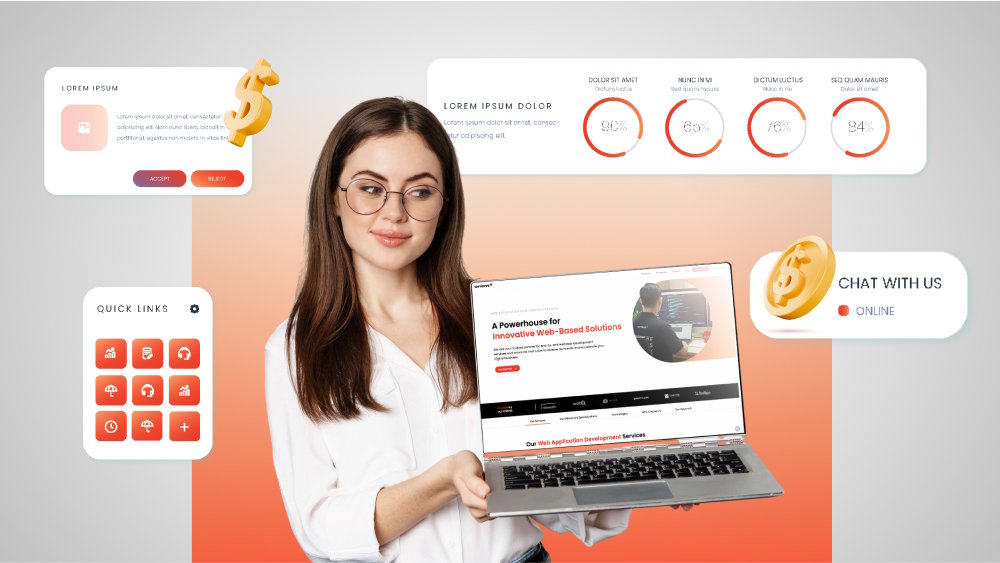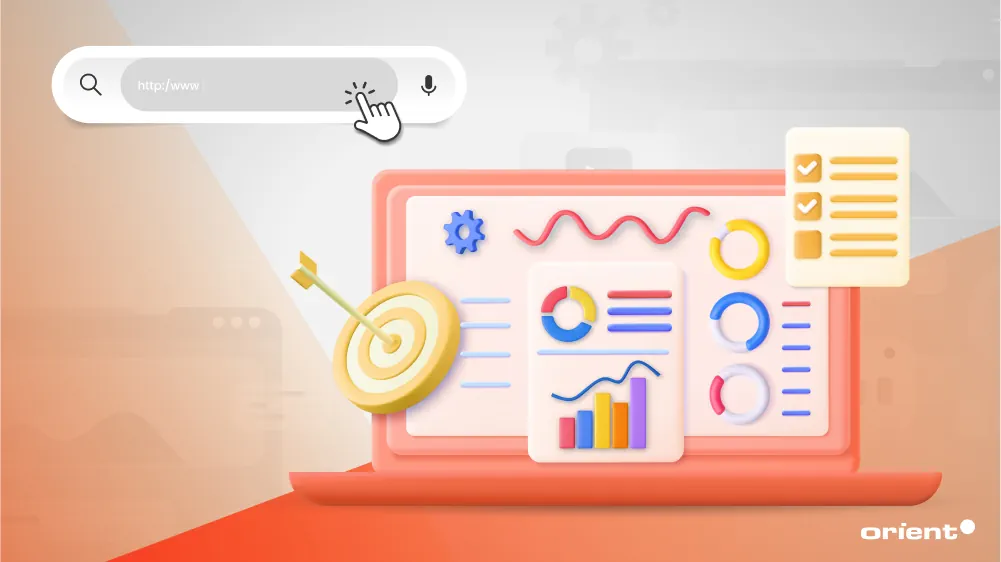
The World of Web Application Types: A Guide for Business Leaders
Not sure what kind of web app your business needs? Start here! We’ve mapped out eight common types of web apps - plus their strengths, weaknesses, and ideal business cases.

Content Map
More chaptersDid you know that Starbucks doubled its daily user activities after launching its progressive web app (PWA)? Desktop orders were nearly the same as mobile orders. Another successful PWA, X Lite (used to be Twitter Lite), observed positive results, including a significant 20% drop in bounce rate, a 75% increase in Tweets, and a 65% increase in pages per session. These impressive results were achieved even with a 97% reduction in the app’s size.
Implementing the right type of web application to meet your customers’ needs plays a major role in any business’ success. It shapes your company’s online presence and demonstrates to users your brand image and business values.
PWAs aren’t your only choice for web application success. There are seven other types for you to choose from, all of which we will examine to help you determine which one is the most suitable for your business. Let’s dive in!
Key Takeaways:
- Web applications operate through a web browser and don’t need to be installed on your device. They typically work on any device without any setup.
- The key difference between a website and a web app is the level of user interactivity. Users can interact with a web app as they would on a mobile app, but web apps don’t have access to a device’s native features (e.g., camera).
- Even though the article lists 8 types of web apps, it’s important to keep in mind that their distinction is black and white. There are many overlaps, and a single web app may be a combination of several web app technologies and approaches.
- Web apps are powerful, but they often run into compatibility, security, and performance issues.
Understanding Web Applications
Definition
First, let’s start with the most basic question: What is a web application?
A web app is software running on a remote server and is used through a web browser over the internet. Unlike traditional apps that need to be installed, web apps work on any device – whether it’s a computer, tablet, or smartphone – without any setup. Online shopping carts, social media feeds, and calculators are all examples of web apps. They help businesses deliver services and connect with users easily, all without the need to download anything.
Users can access a web app through a web browser like Google Chrome or Safari. Here is a simplified explanation of how a web app works.
- A web app needs three basic components: a server, a database, and an application server.
- A user accesses the web app via their chosen web browser. This request travels over the Internet, likely through a number of security measures, to the web server, which handles all the users’ requests.
- The web server sends this request to the web application server, which will execute the task. For example, if the task is querying a database (a repository of all essential information), the application server carries out the task and generates the results.
- The web server receives the results from the web app server.
- The result is then delivered and presented on the user’s device.
Web Applications Vs. Websites Vs. Native Apps

To fully grasp the concept of web apps, it is essential to place them in context alongside other similar technologies: websites and native apps.
A website is a collection of multiple web pages hosted on a server and accessed through a browser. It’s your company’s online presence – utilized to share information, promote products or services, and connect with customers. Built with HTML and hosted on the internet, a website is a key tool for visibility, credibility, and engagement in the digital age.
A native app is software built specifically for one operating system, like iOS or Android, and downloaded directly from app stores, e.g., the Apple App Store or Google Play. Designed to run smoothly on the target platform, native apps can fully access a device’s features like the camera, GPS, or push notifications, offering a fast, reliable, and integrated user experience.
With the basic definitions in mind, here is a brief comparison between them, highlighting the most important aspects.
| WEB APP | WEBSITE | NATIVE APP | |
|---|---|---|---|
| Installation on home screen | Not required | Not required | Required |
| Device compatibility | Any device with a browser | Any device with a browser | Limited to specific devices (iOS or Android) |
| Access via | Internet browser | Internet browser | App store download |
| Offline functionality | Limited or available via PWA | Typically none | Available |
| User interactivity | High–through dashboards, forms, etc. | Not much – mainly for reading and viewing | High interactivity – optimized for mobile interaction |
As seen in the table, web apps and websites are quite similar in structure. Their key difference, however, lies in the level of user interaction: web apps are built for dynamic engagement, while websites are mostly static and informational.
8 Types of Web Applications Explained (with Examples)
With all the basic information nailed down, here are eight types of web applications every business needs to know. This session provides an all-around discussion regarding each type of web app, including its definition, examples, advantages, best use cases (where applicable), and security issues you might encounter.
However, we would also like to highlight that the line between web app types is often blurry. For instance, a single-page application can also be a progressive web application, and both could also be e-commerce apps. It’s common for web apps to combine technologies and approaches to create the best possible user experience.
Even then, attempting to separate the types of web apps helps us better understand their structure, purpose, as well as business value. This breakdown might give you a bigger picture of what type (or types) of web app best fit your needs. Without further ado, let’s dive in!

Static Web Applications
Examples: GitHub pages, Loops, Hugo
A static web application is a type of web app that delivers pre-built content, like HTML, CSS, JavaScript, and images, directly to the user’s browser, without any server-side processing.
This means every visitor sees the same content, regardless of who they are or what they do on the site. While simple in structure, static web apps can still offer rich, interactive experiences using front-end technologies.

Advantages
- Quick loading times: Having a simple structure, pre-rendered content and served directly from a CDN or server translates to a fast loading time that improves user experience and SEO performance.
- Faster development time: Static web applications are simple in structure and essentially display the same content for every user. Hence, an experienced developer can create the components in a short period, sometimes only taking a few weeks.
- Low cost: Small businesses or startups can benefit greatly from static web applications. Its cost to build and maintain it is generally lower, as their development time is faster and lightweight files are cheaper to host.
Drawbacks
- Limited functionalities: Simplicity can be a double-edged sword. Users can’t interact much with the app; there are no real-time notifications or common features like logging in or adding items to a cart.
- Limited scalability: Scaling is a challenge for static web apps. For instance, a simple design change prompts a change in every single web page – imagine repeating the same talk for dozens of pages. Even though it’s possible to scale them up, the task can be quite cumbersome.
Use Cases
It is suitable for small businesses, startups, designers and agencies, and SEO-focused businesses. They work well when you build:
- Simple, content-rich websites: portfolios, blogs, information pages
- Apps with menial backend needs: Single-page applications (SPAs) or apps rendered on the client side or any sites that don’t require personalization or real-time updates.
Dynamic Web Applications
Examples: X (previously known as Twitter), eBay, Blogger, Joomla
A dynamic web application delivers content that changes in real time based on user actions, database queries, or other external inputs. Unlike static web apps that serve the same content to everyone, dynamic apps personalize the user experiences – think user dashboards, real-time updates, or e-commerce sites with search and filtering.

Advantages
- Personalization: Based on user interaction and past purchasing behavior, dynamic web apps allow you to create personalized suggestions, enhancing the overall user experience.
- Encourage dynamic user interaction: Unlike static web apps, dynamic web apps offer users space to fill out forms, post blogs, or even actively provide feedback on their experience.
- Data analytics tools: This kind of website often offers users a built-in data tracking tool, allowing for more efficient personalization.
- Scalability: Dynamic web apps handle large traffic well, so they can grow alongside your business.
Drawbacks
- Security issues: Dynamic web apps have a wider range of surfaces for security vulnerabilities, as they rely on user input, server-side processing, and databases. Hence, strong security measures need to be implemented.
- Complex and take longer to develop: Compared to static web apps, the cost to build a dynamic web app is higher, as it requires more time, energy, and hardware resources. Maintaining it also takes more effort and financial resources.
Use Cases
Dynamic web apps’ interactive features are a great choice if your business wants to deliver personalized content, process data, or offer real-time interactions. We suggest choosing dynamic web apps for online booking systems, social media platforms, e-commerce websites, forums, and media and news outlets.
Single-Page Applications (SPAs)
Examples: Gmail, PayPal, Netflix
A single-page application (SPA) is a type of web app that delivers a smooth, app-like experience by loading a single web page and dynamically updating its content as users interact with it, without refreshing the entire page. SPAs utilize JavaScript to handle navigation and data updates in the background, which means faster interactions, fewer interruptions, and a more seamless UX.

Advantages
- Fast and responsive: SPAs only load the required content and fetch necessary data instead of reloading the entire page, giving users a fast and smooth experience.
- Caching capabilities for offline access: During the initial download, the SPA requests data at the initial data and saves the data it receives. Even when offline, users can access certain parts of the data and use fewer resources.
- Cross-platform compatibility: SPAs are naturally compatible with various devices and platforms, ensuring users have a consistent experience whether on mobile, desktop, or tablet, Android or iOS.
- Debugging with Chrome browser: Using Chrome’s developer tools, developers can debug and spot vulnerabilities efficiently without the need to sift through every single code line.
Drawbacks
- Not SEO-friendly: Most SPAs have a hard time indexing. Since SPAs rely heavily on JavaScript, search engines like Google have difficulty detecting them. Even though Google has gotten better at “reading” JavaScript, SEO is still a challenge for SPAs.
- Browser history management: Unlike traditional websites, SPAs don’t automatically restore the expected page state or scrolling location. This can frustrate users, so developers need to create the “traditional” features manually.
- Security issues: SPAs are vulnerable to cross-site scripting attacks, as they allow users to download the entire application, exposing more surfaces to attackers.
Use Cases
If your business is looking to provide its customers with a platform with a dynamic, rich user interface but with smaller data volume, all while prioritizing the reduction of server load and bandwidth, SPA is the way to go. Its cross-platform capabilities also make it a great candidate for social networks and SaaS platforms. Other relevant cases include messaging apps, project management tools, and streaming services.
Multi-Page Web Applications (MPAs)
Examples: Amazon, eBay
A multi-page application (MPA) is a traditional type of web application where each user action like clicking a link or submitting a form, triggers a full page reload from the server. Each page is served separately, allowing for a clear content structure.

Advantages
- Scalability: Compared to SPAs, MPAs provide users with the flexibility to scale and grow the site as needed. In other words, the MPA grows as your business grows.
- SEO-friendly: Thanks to MPA’s clear structure and each page’s unique URL, crawlers have a much easier time crawling and indexing them. Businesses can also apply comprehensive SEO strategies to each page to attract the highest traffic possible.
- Analytic functions: MPAs are compatible with robust analytic tools such as Google Analytics. Its multi-page structure allows users to use these tools to track important metrics like the number of visitors or purchase history and make timely adjustments.
Drawbacks
- Performance issues: Every time a user refreshes a page, the app reloads the entire page or redirects you to an entirely new HTML page. The more pages your web app has, the more it slows the app’s performance. Developers need to be mindful of this potential challenge.
- Development costs: Having a more complex structure, MPAs typically take a longer time to develop. They also require certain resources from the client-side, such as processors and memory storage, which increases the cost of hosting and maintenance.
Use Cases
MPAs are commonly used for large, content-heavy platforms like e-commerce sites or enterprise tools, where managing multiple distinct pages makes navigation and organization easier.
Progressive Web Applications (PWAs)
Examples: Starbucks, Uber, Tinder, Spotify
Progressive web applications (PWAs) are web apps that blend the best of both worlds: they’re built with standard web technologies like HTML, CSS, and JavaScript but offer the look, feel, and functionality of native mobile apps. PWAs run in a browser, yet can also be installed on a user’s device, work offline, send push notifications, and even access hardware features – just like an app you’d download from the App Store or Google Play.

Advantages
- Service workers: Service workers are the powerhouse behind many of PWA’s desirable features. They are a sort of web worker, a script that runs in the background of your browser, separate from the central browser thread. They enable PWA’s most outstanding features, including:
- Offline accessibility: Service workers can cache key parts of your app, including data and images. You can access the info without an Internet connection.
- Improved performance: Instead of waiting for a service response, they serve cached content instantly.
- Increased conversion rates: The new PWA from AliExpress managed to boost its conversion rates by 104%. PWAs’ near-instant loading time nature plays a crucial role in encouraging users’ engagement, especially in e-commerce applications.
- Low-cost development and maintenance.
Drawbacks
- Compatibility issues: Even though PWAs are meant to be compatible with most available devices and operating systems, this isn’t always the case.
- With iOS devices: Prior to iOS 11.3, PWAs ran into numerous functionality issues, including offline access, background sync, and push notification.
- With legacy systems: Similar to iOS devices, older devices or platforms limit many of PWAs’ core functions.
- Security risks: Should security measures not be implemented properly, PWAs are vulnerable to malicious actors. For example, a misconfigured service worker or unprotected offline storage poses significant security risks.
Use Cases
In the right context, progressive web apps shine bright and elevate your business to the next level. It is ideal for:
- Small businesses that wish to enter the market quickly.
- News and media apps, especially if you wish to deliver content fast in longer session times.
- Travel and hospitality apps, as offline access, boost user experience.
- SaaS platforms where you wish to offer real-time updates and offline access without full native app access.
Content Management Systems (CMS)
Examples: WordPress, Joomla, Shopify
A content management system (CMS) is a system that makes it easy to create, manage, and publish digital content – without needing to write any code. Think of it as the control center for your website or app, where multiple team members can collaborate, update text and images, and keep everything organized from one intuitive dashboard.

Advantages
- Streamlined content management: CMS simplifies almost every aspect that involves creating and managing a website without being proficient in a programming language. CMS offers a central hub to manage your content and intuitive tools to personalize the website to fit your brand image.
- SEO-friendly: CMS comes with built-in tools to optimize your website, making sure it’s easily detectable by search engines and attracts organic traffic.
- Easy collaboration: Multiple users can access and use the CMS at once. They even allow users to assign roles to best streamline the workflow and content management.
Drawbacks
- Security vulnerabilities: CMS needs routine updates and maintenance, as its plugins and core systems are vulnerable to hackers.
- Complexity: This type of web application can take time to get used to, especially for beginners. Its complexity can also cause performance overhead, slowing down overall performance.
- Limited functionalities: Users frequently need to add plugins or modules to meet all their website design needs.
Use Cases
Even though its name might easily suggest CMS is only the best choice for content-centric projects like blogging, there are other situations where it is of great use:
- Blogging: This is the most popular use case for CMS.
- E-commerce: CMS helps you manage product listings and promotional content well.
- Other use cases include corporate and educational websites.
eCommerce Web Applications
Examples: Amazon, eBay, Magento
eCommerce web apps are designed for online shopping and selling. In other words, they are online stores that deliver a dynamic shopping experience for users, including browsing, adding to a cart, checking out, and making online payments.

Advantages
- Wider reach and easy accessibility: eCommerce web apps provide users with the same level of accessibility and fluid user experience, but without needing to install the app onto the device.
- Scalability: Web apps make it easier to scale the growth of products, traffic, and added features and reach new markets.
- More cost-effective than a full-blown mobile app: In certain cases, a web app is cheaper than building and maintaining full-featured mobile applications.
Drawbacks
- Limited access to device features: In comparison with native apps, web apps have more restricted access to device-specific features like push notifications (unless PWA-enabled), cameras, or native payments.
- Security breach risks: Like many other types of web apps, e-commerce web apps are vulnerable to hackers if strong security measures are not put into place.
- Potential browser compatibility issues: Ensuring users have the smoothest shopping experience requires effort in trial and error and fine-tuning the web app.
Portal Web Applications
Examples: Google Workspace Admin Console, banking apps like HSBC, MyChart (by Epic Systems)
A web portal application is a type of website that acts as a centralized gateway to a variety of tools, information, and services, all accessible from a single interface. These portals typically require users to log in, offering personalized dashboards and content based on the user’s role or preferences. Whether it’s an employee portal, a student dashboard, or an online banking system, web portal applications help streamline access and improve the user experience by consolidating everything in one secure place.

Advantages
- Secure environment: With proper security measures, such as authentication or access control, put in place, web portal apps are a safe and secure environment for users’ data and information.
- Centralized access: This web app offers a central access point for all of the user’s resources, information, without the need to navigate multiple systems at once.
- Personalized experience: Not only can users easily find the information they need, but they can also personalize the application to their preferences and needs.
Drawbacks
- Security risks: Even with layers of protection, web portal apps are still prime targets for cyberattacks, especially for the sensitive information they tend to house.
- Complexity: The development process of portal web apps takes more time, effort, and money. This is due to its complex features and advanced user management, which come with a higher security standard and advanced user management.
Potential Challenges of Web Applications for Businesses

There are common challenges that almost every type of web app encounters. We’ve summarized the most common challenges businesses might face when implementing web apps.
Security Threats
Web apps are exposed to a variety of security threats. Relying heavily on the Internet, web apps are more vulnerable to data breaches, phishing attacks, and hackers. Hence, companies need to implement strict security measures and comply with global and national security standards to safeguard its data and users.
Functionality Restrictions
As versatile and beneficial web apps are, they can’t do everything. Web apps sometimes struggle with tasks native apps perform with ease partly due to its limited access to native hardware and operation systems.
Compatibility with Other Systems
While web app development teams aim for cross-platform compatibility, the different standards and features prove to be challenging. It can be quite difficult to deliver a consistent user experience and performance across various platforms, systems, and devices. Sometimes, companies need to work extra hard to fix compatibility issues, costing more money and time.
Wrapping Up

Web applications play a large part in Internet user’s daily online experience. It is important to deliver the right type of web app for the intended purpose, product, and target audience. After all, web apps are part of your business’ online presence and portray your business’ value.
It’s time to partner up with a credible partner and uncover the type of web app that elevates your company. No need for a fancy start – what matters is taking the first few steps with the right intention and planning. Don’t hesitate and contact the Orient Software team to take the first steps!






